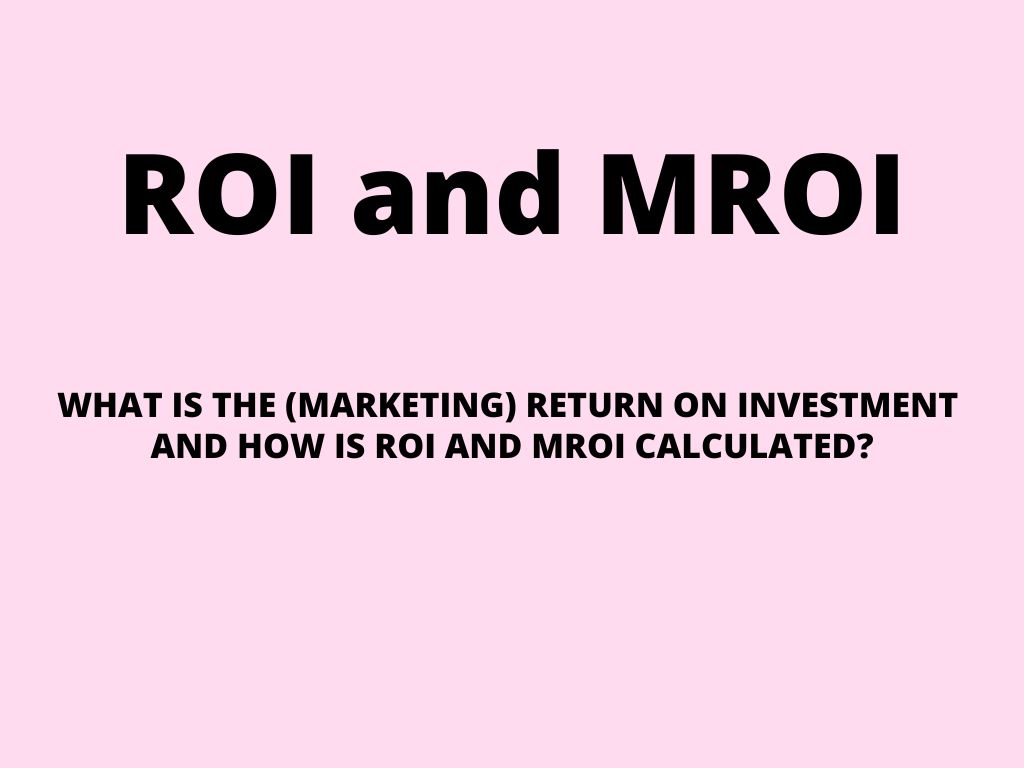
Marketing ROI – what is the (marketing) return on investment and how is ROI and MROI calculated?
ROI, short for return on investment, is a widely used metric in business to assess the effectiveness of investments in generating revenue. At its core, ROI measures the ratio of what you gain compared to what you invest.
What is ROI?
The concept of ROI is straightforward. It enables you to evaluate the financial performance of your investments by calculating the return you receive relative to the cost incurred. By understanding the ROI of your investments, you can determine their profitability and make informed decisions about resource allocation.
To calculate ROI, you need to subtract the initial investment cost from the final value generated and divide it by the initial investment cost. The result is typically expressed as a percentage or ratio, representing the return on your investment.
ROI provides valuable insights into the efficiency and success of your investments. It helps you identify which investments are generating positive returns and which may need adjustments or reevaluation. By analyzing ROI, you can optimize your decision-making process, allocate resources effectively, and drive overall business growth.
In summary, ROI is a fundamental metric that allows you to assess the performance of your investments in generating revenue. It provides a clear understanding of the value you receive in relation to the resources you allocate, helping you make informed decisions to maximize profitability and drive business success.
Marketing ROI (MROI) – what it is?
Companies spend trillions of dollars on marketing each day, yet marketing often gets labeled as a cost center rather than a profit driver. The key to changing this perception lies in proper planning and measurement. The ability to measure and justify marketing spend is what separates a profitable investment from wasteful expenditure.
This is where Marketing ROI (MROI) comes into play. Instead of relying on gut feelings when investing in marketing channels, Marketing ROI provides a way to measure the overall success and returns of marketing campaigns.
So, what exactly is Marketing ROI?
It is a metric that measures the return on marketing investment within an organization. In simpler terms, it quantifies the revenue generated from a company’s marketing spend, which includes various components such as overhead costs, salaries, media buys, creative services, and more.
The ultimate objective of any marketing operation is to accurately measure the return on every dollar invested and the revenue generated from that investment. In the past, this was mostly guesswork, but with the advent of digital marketing, marketers now have the tools to more precisely measure their marketing costs and the resulting revenue.
Why is Marketing ROI so crucial? Successful marketing organizations rely on data-driven decision-making. Understanding attribution, fraud, and misattribution is vital for achieving profitable marketing performance. By leveraging Marketing ROI, companies can gain valuable insights into the effectiveness of their marketing efforts, identify areas of improvement, and optimize their strategies for maximum returns.
In summary, Marketing ROI is a powerful tool that allows organizations to measure the impact of their marketing investments. By utilizing data and analytics, businesses can make informed decisions, drive profitability, and establish marketing as a revenue-generating function within the organization.
MROI vs ROAS comparison and understanding the key differences
ROI and ROAS are two widely used metrics in marketing that provide valuable insights into the effectiveness of advertising campaigns. While these acronyms are often used interchangeably, there are distinct differences between them.
ROAS, or Return on Ad Spend, focuses specifically on measuring the revenue generated per dollar spent on a particular advertising campaign. It provides a granular analysis of the campaign’s performance and helps marketers evaluate the success of their ad investments.
On the other hand, MROI, or Marketing Return on Investment, takes a broader perspective and assesses the overall impact of marketing efforts on a company’s profitability. It considers the collective effect of multiple marketing campaigns and initiatives, providing a high-level view of marketing performance.
The importance of marketing ROI for marketers
Marketing ROI, represented by metrics like MROI, plays a vital role in the strategic decision-making process of marketers. Here are a few reasons why marketing ROI is crucial:
- Justifying Marketing Spend: MROI helps marketers demonstrate the value and effectiveness of their marketing activities. By quantifying the impact on the company’s bottom line, it enables marketers to justify their investments and secure resources for future campaigns.
- Leading Indicator of Performance: MROI serves as a leading indicator of marketing performance and profitability. It provides executive leaders with valuable insights into the return generated from marketing efforts, allowing them to make informed decisions about resource allocation and strategic direction.
- Accountability and Optimization: MROI holds marketing teams accountable for their actions by measuring the tangible impact on the company’s financial success. It encourages marketers to carefully consider how they allocate their time and budget, driving optimization and efficiency in marketing strategies.
- Strategic Planning: Accurately calculating MROI enables marketers to establish a long-term strategic roadmap. It guides decisions related to channel investments, budget allocation, and talent acquisition, and tracks spending patterns over time. MROI serves as a guiding principle for aligning marketing goals with overall business objectives.
While MROI is a valuable metric, it should be noted that it is not the sole measure of marketing success. It should be used in conjunction with other key performance indicators to gain a comprehensive understanding of marketing performance and inform data-driven decision-making.
In conclusion, understanding the differences between ROI and ROAS is essential for marketers. MROI provides a holistic view of marketing impact, whereas ROAS focuses on the performance of individual advertising campaigns. By leveraging both metrics effectively, marketers can optimize their strategies, demonstrate the value of marketing efforts, and drive long-term business success.
Let’s break it down – 3 steps to measuring your marketing return on investment (ROI)
To calculate marketing ROI, you can use the following formula:
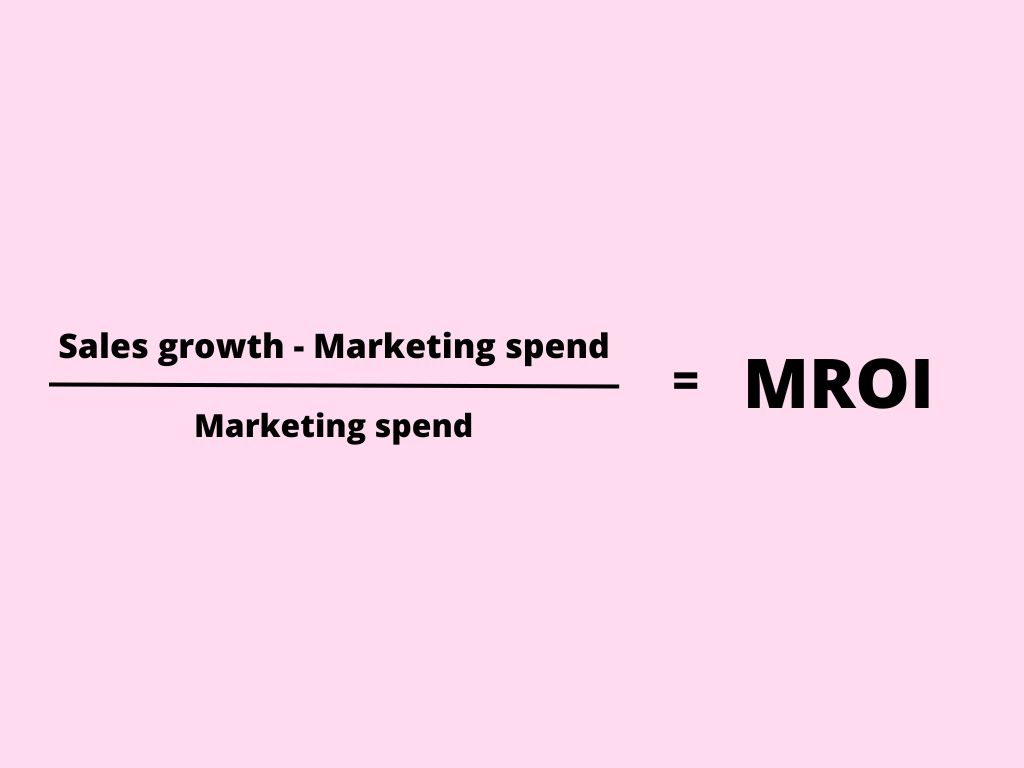
However, determining the total marketing spend and defining sales growth can be challenging. To ensure accuracy, follow these steps:
Step 1: Identify your key performance indicators (KPIs)
Since every business is unique, measuring marketing ROI requires considering multiple metrics aligned with your campaign goals. To justify your marketing budget, determine the KPIs most valuable to your business. Some examples include:
- Cost per lead (CPL)
- Customer acquisition costs (CAC)
- Customer lifetime value (LTV)
- Conversion rates
- Average order value (AOV)
- Purchase frequency (PF)
- Customer average lifespan (CAL)
Step 2: Determine your attribution model
Marketing attribution involves identifying the touchpoints that lead to conversions. Understanding which touchpoints have the greatest impact on conversions helps identify the channels, campaigns, and factors contributing the most to your bottom line. Attribution models can include:
- First touch attribution: 100% credit to the first touchpoint
- Last touch attribution: 100% credit to the last touchpoint
- Time decay: More credit to touchpoints closer to conversions
- Linear: Equal credit to all touchpoints
- Multi-touch attribution: Considering multiple touchpoints and assigning credit based on specific logic per business
Step 3: Select the metrics to measure
There is no single metric that determines a good marketing MROI, as it depends on various factors such as market conditions, business stage, campaign stage, unique KPIs, and revenue goals. Different organizations may use different formulas to calculate marketing MROI, such as:
- Hubspot marketing ROI formula
Hubspot calculates MROI by using the formula:
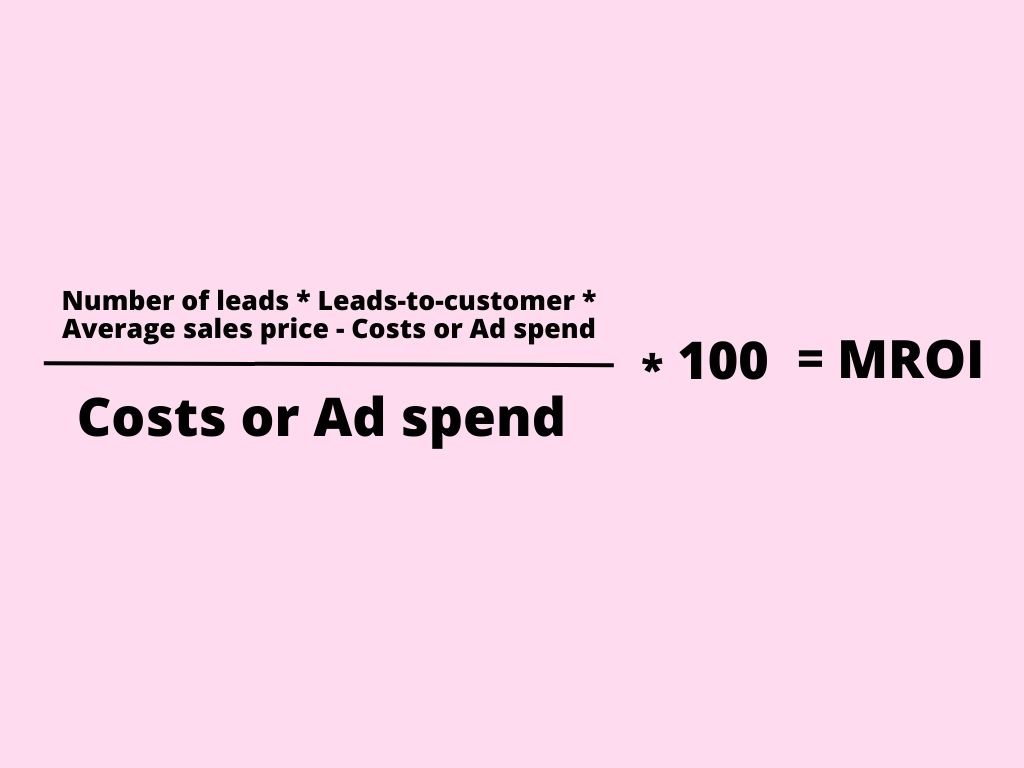
- The alternative marketing ROI formula
In contrast, another organization may use the following formula to calculate MROI:
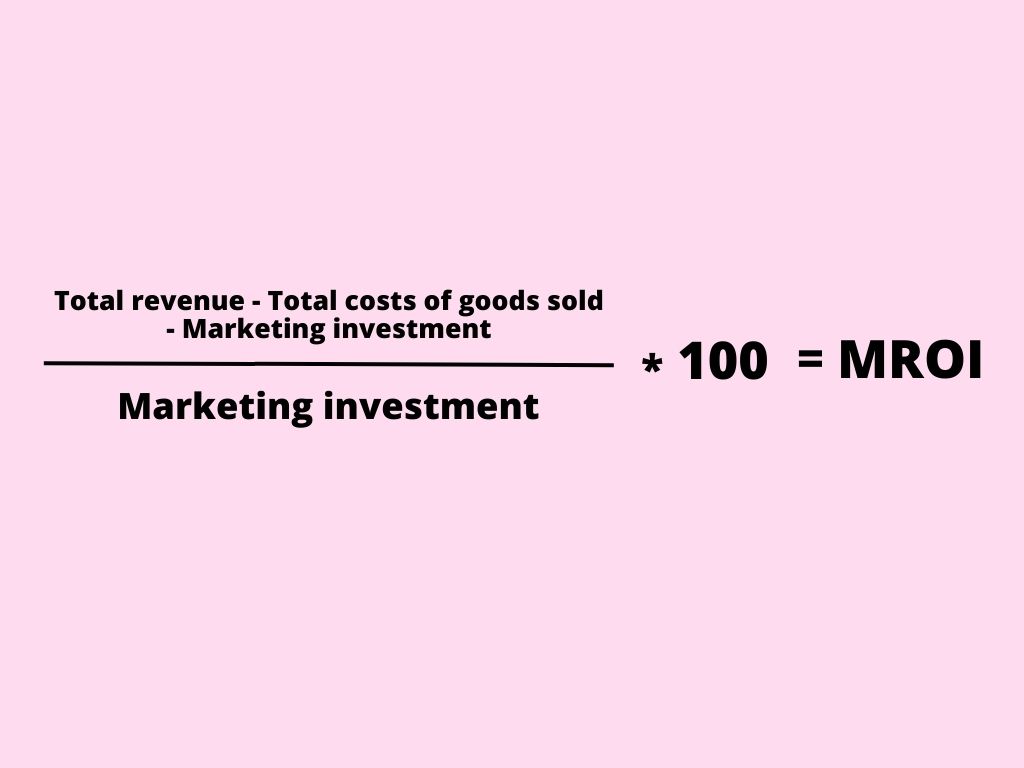
- Marketing ROI formula based on customer LTV
Or when you consider that customer LTV is the most important metric to your business, you will use this formula:
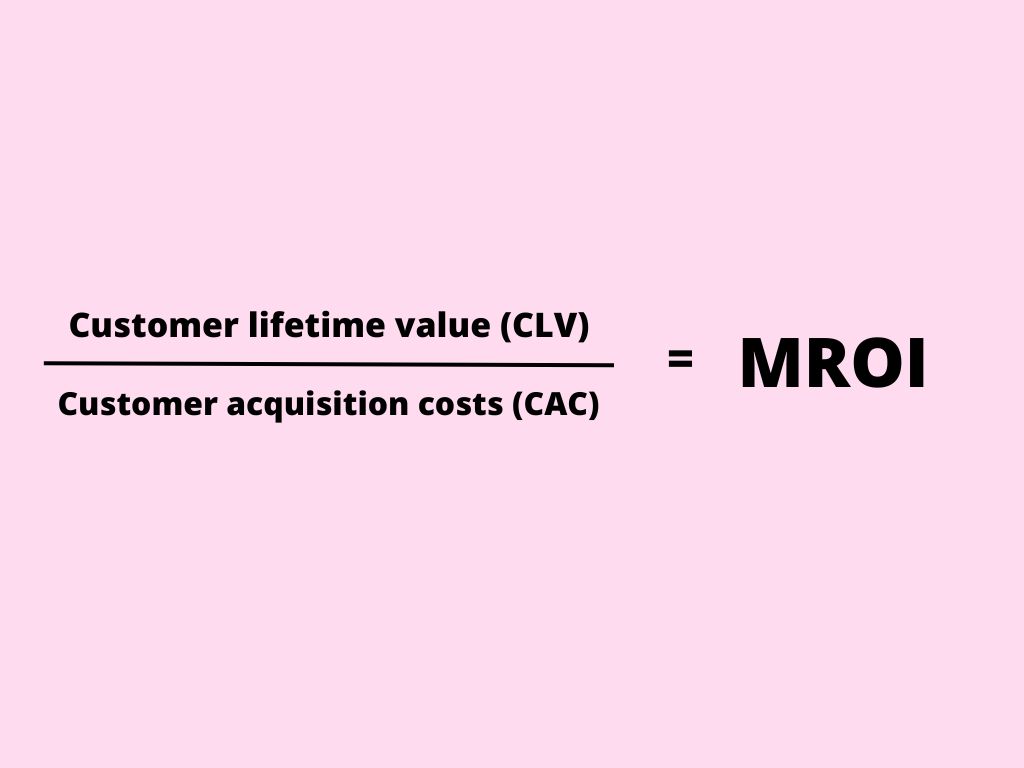
Ultimately, use the metrics that are most relevant to your business and complement your MROI calculations with contextual data to obtain a comprehensive understanding of your marketing returns.
How to determine a good marketing ROI?
As discussed in the previous chapter, determining what constitutes a good marketing ROI (MROI) is highly subjective and specific to each business. There is no universally applicable golden ratio that indicates a good MROI. Instead, marketers should focus on ensuring their data is clean and accurate, identifying their key metrics, and calculating their overall marketing performance based on their unique customer needs and behaviors.
The main challenges of marketing ROI
Obstacles on the path to accurate marketing ROI While MROI is intended to provide a comprehensive view of marketing performance, there are common challenges that can undermine its effectiveness, even with advancements in attribution technology. Often, marketers are unaware that their calculations are inaccurate or incomplete. Here are the four most common reasons for this:
- Inaccurate data sources: A significant challenge for marketers in measuring MROI is the accuracy of attribution. Regardless of the sophistication of your business intelligence team, actionable insights rely on measuring the right parameters. Ensuring confidence in your numbers requires reducing fraud and misattribution, which can be achieved by partnering with a trusted mobile measurement platform (MMP) and utilizing predictive modeling.
- Not included labor costs: Many marketers only consider advertising costs in their MROI calculations. However, for a more accurate measurement, it is necessary to incorporate all the factors involved in campaign management, from ideation and strategy to creative execution and reporting. This includes accounting for the costs of full-time employees and designers involved in crafting advertising campaigns, in addition to the expenses of placing ads.
- Undervaluing brand marketing: MROI calculations can sometimes encourage a narrow focus on short-term results, neglecting the long-term value of building brand equity. Brand recognition plays a crucial role, particularly in highly competitive markets where differentiation is essential. When the primary metric is sales numbers without considering sales cycles and customer lifetime value (LTV), MROI calculations may lead to short-term decision-making.
- Ignoring other data: MROI should be considered as just one part of the overall marketing equation. Business decisions should never rely solely on MROI but should be supplemented with contextual information such as market factors, competition, and the company’s stage. For example, the impact of privacy laws like Apple’s App Tracking Transparency (ATT) policy can significantly affect advertising costs. Even if your campaigns are performing well relative to the market, it could still impact your MROI calculations.
Often, marketing efforts don’t yield positive ROI immediately. For instance, Search Engine Optimization (SEO) is a prime example of a strategy that requires six months or more to see positive results. Similarly, there are situations where substantial upfront investment is necessary to kickstart marketing campaigns and build initial momentum.
App Marketing ROI
Measuring marketing ROI can be both challenging and rewarding, especially when it comes to app marketing. App marketers need to adopt a unique approach to calculating ROI due to specific hurdles they face.
Here are a couple of obstacles that make measuring App Marketing ROI (MROI) challenging:
Fragmented cost data
One major challenge for app marketers is obtaining accurate cost data while dealing with various sources. Data reporting across different platforms, such as Twitter, Facebook, and Snapchat, vary in terms of format, frequency, and granularity. This fragmentation and lack of standardization make it difficult to compare and weigh the costs accurately.
Additionally, with the introduction of App Tracking Transparency (ATT), marketers must gather data from multiple sources, including aggregated deterministic data from SKAdNetwork, user-level data from ATT consenting users, and aggregate data from probabilistic modeling, among others. To tackle this challenge, working with a mobile measurement provider (MMP) that can collect, organize, and standardize cost reporting using multiple data collection methods is essential.
Lack of awareness of true ROI
Some marketers are unaware of their true ROI due to distorted data caused by sophisticated fraud and false attribution. This leads to significant financial losses, often amounting to millions or even billions of dollars, creating what is known as “the bleeding cash cycle.”
Addressing this issue requires implementing robust fraud detection mechanisms and attribution models that can accurately identify genuine conversions and attribute them to the appropriate marketing sources.
Overall, app marketers must navigate these challenges to gain a clear understanding of their marketing ROI and make informed decisions to optimize their app marketing strategies.
When fraud compromises your data, your calculations become meaningless and unusable. It not only wastes your valuable time and resources but also sets you back steps, leaving you without any actionable insights to work with.
Essential steps to measure your app marketing ROI effectively
Step 1: Validate your data sources
The initial step involves ensuring the reliability and accuracy of your data sources. As mentioned earlier, partnering with a reputable mobile measurement provider (MMP) is crucial. Take the necessary measures to validate your data sources, eliminating any fraudulent or unreliable data that may skew your calculations.
Step 2: Determine your key performance indicators (KPIs)
Calculating app marketing ROI goes beyond a simple revenue-to-marketing spend ratio. Due to the diverse variables involved in marketing different types of apps, there is no one-size-fits-all formula for measuring app marketing ROI. Embrace the fact that app marketing ROI carries a degree of uncertainty and focus on identifying KPIs that have a direct correlation to your revenue figures.
Consider leveraging the AARRR framework (Acquisition, Activation, Retention, Referral, Revenue) to establish goals, signals, and metrics that define the success of your app marketing campaigns. This framework provides a comprehensive approach to tracking the various stages of user engagement and conversion.
| Goals | Signals | Metrics |
| Acquisition | Users understand the benefits and features of your app | – User downloads – Positive social media sentiment – Brand awareness – Downloads – App store ranking – Cost per acquisition Cost per install – CPI per campaign |
| Activation | Users complete their desired action | – User in-app activity – Number of onboarded users – Goal completions – DAU / MAU – Length per session – Goal completions – Cart abandonment |
| Retention | Users return and use your app regularly | – Repeat orders – User frequency – Shorter time between sessions – Increased feature usage – Churn rate – Session frequency – Session duration |
| Referral | Users talk positively about your app and drive more downloads | – App reviews on app store and 3rd party review sites – Positive press – Increased social media and forum sentiment – Number of reviews – User invitations – Customer Lifetime Value – Referral retention rates – Install per invite – Net Promoter Score (NPS) |
| Revenue | Users spend money on your app | – In-app purchases – Freemium subscription upgrades – Purchase frequency – Average transaction value – Average revenue per user – Customer Lifetime Value – Average order value – MRR / ARR |
Step 3: Calculate the most relevant metrics
To measure your app marketing ROI effectively, it is important to select the most relevant metrics for your app. One approach is to consider metrics such as the total value of post-install actions or average revenue per user (ARPU).
If you choose to focus on ARPU, you can calculate your app marketing ROI by comparing it to the cost per loyal customer (CPLU). If your ARPU exceeds your CPLU, it indicates a positive ROI for your app marketing efforts.
Step 4: Analyze and refine your app marketing strategies
Once you have reliable data sources and defined KPIs in place, it’s time to analyze your app marketing efforts and refine your strategies accordingly. Regularly evaluate your campaign performance, align it with your established KPIs, and make data-driven decisions to optimize your app marketing ROI.
By following these steps, you can enhance your ability to accurately measure and improve your app marketing ROI, leading to more effective and efficient marketing strategies for your app.
The best practices for achieving a positive MROI in 2022
- Ensure accurate attribution data: Accurate data is crucial for calculating MROI effectively. By utilizing a trusted Mobile Measurement Partner (MMP) and reducing fraud and inaccuracies, you can make informed data-driven decisions with confidence.
- Avoid vanity metrics and focus on what truly matters: Metrics like page views, social media followers, and app users alone are not sufficient for assessing the marketing performance. Instead, prioritize revenue-tied metrics such as customer lifetime value (LTV), average order size, retention rates, and daily active users. These metrics provide meaningful insights into the effectiveness of your marketing campaigns.
- Look at the entire funnel: A common pitfall in calculating MROI is having a narrow focus on short-term revenue numbers. To maximize the effectiveness of your marketing efforts, consider the entire customer journey and how marketing activities impact various funnel stages. Evaluate metrics such as retention rates, referral rates, and average order values to gain a comprehensive understanding of your MROI.
Key information about the return on investment (ROI) to remember
- MROI measures the revenue generated from marketing activities and varies across organizations.
- MROI examines overall marketing spend, while return on ad spend (ROAS) focuses on specific campaigns.
- MROI justifies marketing investments, offers a holistic view of performance, and aids in long-term strategic planning.
- Inaccurate data sources can hinder MROI effectiveness, so partnering with a reliable MMP is crucial.
- App marketing ROI poses unique challenges due to fragmented cost data and a lack of standardization across channels.
To maximize your MROI, prioritize accurate data, focus on meaningful metrics, and consider the complete customer journey in your analysis. Remember to approach MROI with a positive mindset and embrace the opportunities it presents.
Was this article helpful?
Support us to keep up the good work and to provide you even better content. Your donations will be used to help students get access to quality content for free and pay our contributors’ salaries, who work hard to create this website content! Thank you for all your support!
Reaction to comment: Cancel reply